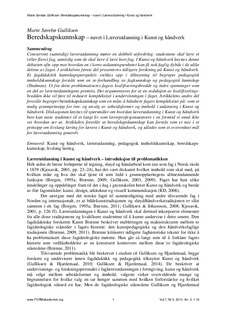Beredskapskunnskap - nnavet i Lærerutdanning i Kunst og håndverk
Journal article, Peer reviewed
Published version
Permanent lenke
http://hdl.handle.net/11250/2438155Utgivelsesdato
2014Metadata
Vis full innførselSamlinger
Originalversjon
Gulliksen, M.S. Beredskapskunnskap - navet i Lærerutdanning i Kunst og håndverk. FORMakademisk 2014, 7(5) 10.7577/formakademisk.902Sammendrag
Concurrent (samtidig) lærerutdanning møter en dobbelt utfordring: studentene skal lære et (eller flere) fag, samtidig som de skal lære å lære bort fag. I Kunst og håndverk knyttes denne debatten ofte opp mot hvordan en i korte utdanningsenheter kan få nok faglig dybde i de ulike delene av faget. I artikkelens første del presenteres tidligere forskning på Kunst og håndverk. Et fagdidaktisk kunnskapsperspektiv trekkes opp i tilknytning til begrepet pedagogisk innholdskunnskap forstått som en re-forhandling av fagkunnskap og pedagogisk kunnskap (Shulman). Ut fra dette problematiseres fagets kvalifiseringsbredde og indre spenninger som en del av lærerutdanningens premiss. Det argumenteres for at en reduksjon av kvalifiseringsbredden ikke vil føre til redusert kompleksitet i undervisningen i faget. Artikkelens andre del foreslår begrepet beredskapskunnskap som en måte å håndtere fagets kompleksitet på: som et mulig grunnprinsipp for inn- og utvalg av arbeidsformer og innhold i utdanning i Kunst og håndverk. Diskusjonen knyttes til spørsmålet om hvordan lærerutdanning i Kunst og håndverk best kan ruste studenter til et langt liv som lærerprofesjonsutøvere i en fremtid vi ennå ikke vet hvordan ser ut. Artikkelen foreslår at beredskapskunnskap kan forstås som et nav i et prinsipp om livslang læring for lærere i Kunst og håndverk, og således som et overordnet mål for lærerutdanning generelt. Concurrent teacher education involves a double challenge: the students learn one (or more) subjects while they learn to teach those subjects. In Arts and Crafts, this debate often contains questions of how teacher-students, taking short courses on a subject, can acquire enough academic depth in the different areas of the subject. The first part of the article presents earlier research on Arts and Crafts and the concept of ‘pedagogical content knowledge’, understood as a re-negotiation of subject content knowledge and pedagogical knowledge (Shulman). The qualification width (the number of areas) and inner tension (between the areas) in the subject of Arts and Crafts is discussed, ending with the conclusion that a reduction of qualification width will not lead to reduced tension or complexity in teacher education within the subject. The second part of the article proposes the concept of ‘preparatory knowledge’ as an alternative way to manage complexity in teacher education in Arts and Crafts: as a possible basic principle for choosing content and methods. The discussion is linked to the broader educational question of how teacher education in Arts and Crafts can best equip students for a long life as professional practitioners in an unknown future. The article proposes that preparatory knowledge can be understood as a hub in a principle of lifelong learning for teachers in Arts and Crafts, and thus as an overarching goal of teacher education in general.

